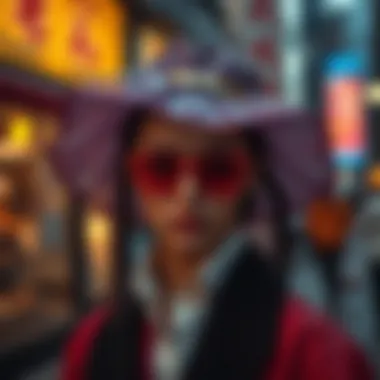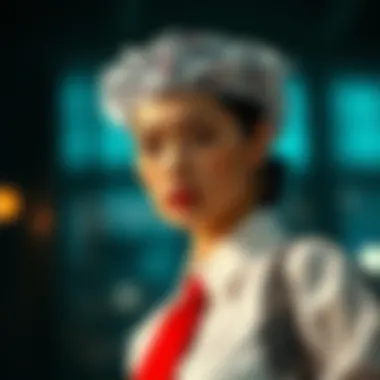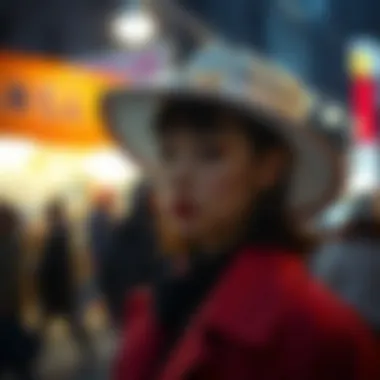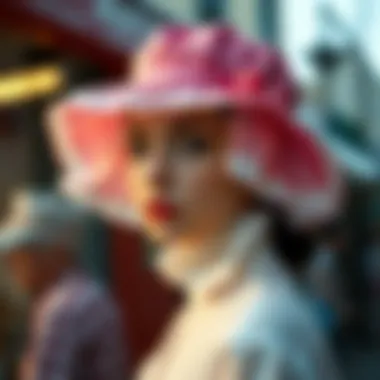The Evolution and Utility of Disposable Hats in Fashion


Intro
The conversation surrounding disposable hats is more relevant than ever in today’s fast-paced fashion landscape. Both function and fashion fuse in these unique accessories, combining convenience with style. Historically, hats have represented various social cues, influences, and trends. However, the emergence of disposable hats shakes the traditional view of headwear, positioning it as a staple in a world where speed often trumps sustainability.
For instance, when one thinks of a disposable hat, images of picnic gatherings or outdoor festivals may come to mind. Yet, these caps have carved a niche in high-profile environments like fashion runways, where designers experiment boldly with materials that challenge conventions.
Key Points of Discussion
The article will chart an evolution that intertwines history with modern utility. Key points to expect include:
- Historical Context: Tracing where disposable hats started and how they differ from their traditional counterparts.
- Material Implications: Investigating what these hats are made from and how that affects their environmental footprint.
- Multifunctional Uses: Exploring how disposable hats have crossed from practical functions into the realm of style, appearing in various public arenas.
- Sustainability Concerns: Weighing convenience against environmental considerations—are disposable hats a short-term trend or a lasting solution?
Readers, particularly stylists, fashion designers, and retailers, will find a treasure trove of insights. By deep diving into the intricacies of disposable hats, the article intends to shed light on their evolving role in contemporary fashion, pushing boundaries and challenging preconceived notions.
Understanding Disposable Hats
The phenomenon of disposable hats has gained traction as a noteworthy topic within the fashion industry. Disposable hats are not just random accessories; they symbolize a fusion of practicality and modern fashion sensibility. As consumers increasingly seek convenience and versatility in their wardrobes, understanding the role of these hats becomes essential. These headpieces offer various benefits, including protection from elements, cost-effectiveness, and adaptability to different social settings.
Definition and Characteristics
Disposable hats are designed to be worn casually and discarded after use, often made from lightweight materials. They vary in shape and style, but typically they are simple and functional. Some common characteristics include:
- Lightweight Fabric: Often composed of non-woven polypropylene, paper, or nylon, making them easy to wear and transport.
- Affordability: Priced to meet budget-conscious consumers, these hats present a practical option without jeopardizing fashion.
- Variety: Ranging from basic caps to colorful visors, their designs can cater to different tastes and occasions.
- Customization Potential: They can be branded or personalized, making them a popular choice for events and promotions.
These characteristics not only define the disposable hats but also their effectiveness in diverse scenarios, reinforcing the need to appreciate their various aspects.
Historical Overview
To grasp the significance of disposable hats, it's vital to consider their historical journey. The origins can be traced back to the 20th century, where practical headwear was essential, especially in outdoor events and jobs that required protective gear. In the mid-1900s, while trendy hats like fedoras or berets ruled the mainstream fashion, disposable alternatives began creeping into public consciousness.
About the 1960s and 70s, the rise of events such as concerts and sports games ushered in a need for affordable yet functional types of headwear. This demand primarily stemmed from the notion that guests at such gatherings wanted to protect themselves from sun exposure without the commitment of long-term investments in stylish headgear.
By the 2000s, disposable hats progressed beyond just functional wear. They began appearing in festivals, outdoor parties, and corporate events as a trendy statement piece. The landscape has only further enriched these hats with innovations in fabric and design, leading to their enduring place in today’s fashion arena.
The evolution showcases how disposable hats transitioned from mere utilitarian pieces to becoming an indispensable component of accessory wardrobes across various demographics. This history not only adds depth to their utility but invites further exploration into their place in modern fashion.
Material Composition
Understanding how disposable hats are made is crucial for comprehending their role in modern fashion and society. The material composition not only affects the overall aesthetic of the hats but also determines their practicality and environmental impact. This section delves into the specific materials used in their production and the importance of considering these factors.
Common Materials Used


Disposable hats are commonly crafted from materials that prioritize durability and cost-effectiveness. Here are several of the most frequently used materials:
- Non-woven Polypropylene: This lightweight material is favored for its ability to resist water and contamination, making it ideal for health-related usage, such as in hospitals and kitchens.
- Paper: Often found in promotional hats, paper is easy to print on and customize, making it an attractive option for events and marketing campaigns. However, it lacks water resistance and durability when exposed to the elements.
- Plastic: This material often appears in party hats or novelty items. Plastic can be molded into various shapes but raises concerns about environmental degradation.
- Bamboo Fiber: An eco-friendlier alternative, this biodegradable approach is gaining popularity. Bamboo is known for its strength and sustainability, providing a more environmentally conscious choice.
Each of these materials offers unique benefits, balancing the need for functionality and style. By selecting appropriate materials, companies can meet consumer expectations while addressing their environmental responsibilities.
Environmental Considerations
When discussing disposable hats, overlooking the environmental implications would be a grave mistake. As society is continually moving towards sustainability, the material choice plays a pivotal role in this transition. Here are several key considerations:
- Biodegradability: Not all materials decompose at the same rate. Biodegradable options, like bamboo fiber, prevent adding to landfill waste, distinguishing them from traditional plastic hats that can linger for centuries.
- Production Impact: The process of creating these materials can also cause environmental strain. Synthetic fibers demand extra energy and water resources, while natural options typically require less intense processing, benefiting the environment.
- Recycling Potential: Materials like polypropylene can sometimes be recycled, though recycling practices vary greatly depending on local facilities. Hence, it’s essential for manufacturers and consumers to educate themselves on disposal methods to enhance circular sustainability.
To sum up, the composition of disposable hats greatly impacts their performance, design appeal, and environmental footprint. By integrating thoughtful selection of materials, the fashion industry can progress toward meeting consumer needs without sacrificing ecological responsibility.
"The fashion world must evolve to create products that reflect both the creativity of the designers and the sustainability of the materials used." - Unknown
For those wishing to explore more about the environmental impacts of various materials, resources like Wikipedia and Britannica provide in-depth analyses.
Applications in Everyday Life
Disposable hats have seeped into numerous facets of daily life, illustrating their versatility and ease. In various contexts, these hats serve multiple purposes ranging from fashion to function. Understanding how they integrate into everyday scenarios broadens our appreciation for their role, utility, and significance.
Fashion Statements
In today’s image-centric world, disposable hats have become subtle but effective fashion statements. They often provide a unique flair to an outfit without the commitment of traditional headgear. A bold-colored disposable bucket hat, for example, can transform a mundane ensemble into a trendsetter’s delight. The appeal lies in their availability in diverse styles and colors, catering to a wide demographic. They are not just about protecting against the elements, but also about complementing attire and expressing personal style.
With brands embracing the trend, you may see designers pushing the envelope, creating sophisticated versions of these hats that challenge preconceived notions. Moreover, they cater to spontaneous fashion choices; if you're unsure about a style, a disposable hat is low-risk — no long-term investment required.
Event Use Cases
Events have become hubs of creativity and self-expression, and disposable hats play a vital role in this arena.
Concerts
When it comes to concerts, disposable hats are a hit. With countless people standing shoulder to shoulder, a hat not only protects the wearer from the sun but also adds to the festive atmosphere. They often feature vibrant prints or even band logos, making them a popular choice for fans looking to showcase their allegiance.
One characteristic that makes disposable hats a staple here is their lightweight nature; no extra bulk means freedom to dance and groove. However, they can be seen as less durable. When the night winds down, many hats might end up discarded on the ground, raising questions of environmental responsibility due to their single-use nature.
Festivals
At festivals, disposable hats are practically a rite of passage. The sun-soaked days and energetic nights create scenarios where a hat can be as important as a ticket. They’ve become synonymous with festival attire, offering a practical solution for sun protection while letting revelers express their individuality.
A standout feature of festival hats is the eclectic designs—think flower crowns made from eco-friendly materials or vibrant prints that match the wild ambiance. Yet, just like at concerts, the transient nature of these items can lead to conversations about sustainability. Participants love them, but how many end up in landfills?


Corporate Events
In the business arena, disposable hats have emerged as essential items during corporate functions, particularly outdoor gatherings. They serve both as ice breakers and branding tools. A company logo on a chic disposable hat can facilitate informal networking, allowing participants to express personal style while subtly promoting the brand.
The appeal lies in their practicality. From picnics to team-building events, they offer protection from the sun while maintaining a polished appearance. However, they can also be perceived as a one-time accessory, raising questions about the lasting impressions they leave.
Health and Safety Usage
Shifting focus to health and safety, disposable hats assume a functional role beyond mere aesthetics. In medical settings, or during public health crises, these hats serve as barriers, keeping germs and debris at bay. Notably, during the COVID-19 pandemic, hats fashioned from certain materials would help shield against contaminations in food-related industries and hospitals.
Employers in sensitive environments appreciate the convenience of disposable health hats. They are lightweight, easy to store, and allow for hygienic practices, especially in places where one-time use is pivotal. However, there’s a constant dilemma regarding their environmental impact, as single-use items raise significant sustainability concerns.
Overall, the utility of disposable hats in everyday life spans across fashion, events, and public health, each bringing its unique nuances and challenges that underscore their multifaceted nature.
The Role of Disposable Hats in Fashion Trends
Disposable hats have carved a significant niche within the landscape of modern fashion. As society evolves, so does its approach to accessories, with disposable hats emerging at the intersection of style, utility, and sustainability. The versatility of these hats makes them integral not just for protective purposes but also as a bold statement in the fashion world. Designers and brands are increasingly recognizing their potential to address both the aesthetic and functional needs of consumers, especially in a world that values convenience alongside conscientiousness.
Current Trends
In today’s fast-paced environment, disposable hats are striding into the limelight, reflecting current trends that prioritize adaptability and practicality. They are no longer just plain headgear but have transformed into eye-catching accessories adorned with intricate designs and vibrant colors. You can spot everything from basic paper caps at outdoor festivals to high-end, limited-edition designs featured in high-stake fashion shows.
- Streetwear Influence: The current streetwear movement has encouraged an acceptance of unconventional materials, including those used for disposable hats. Brands like Off-White and Supreme are playing with the idea of multi-functional pieces that can be worn once and regifted, showcasing how disposable hats fit into this trend.
- Celebrities and Influencers: With influencers sporting trendy disposable hats in their everyday wardrobes, the fashion community is embracing these items. A recent photoshoot featuring Gigi Hadid captured her in a disposable hat, combined with luxury apparel, demonstrating that high fashion can integrate disposables beautifully.
- Event-Specific Designs: Events such as music festivals and corporate gatherings have given rise to tailored variations of disposable hats, designed specifically for those occasions. You often see branded hats at concerts or expos, serving both promotional and stylish functions.
Cultural Impact
The cultural implications of disposable hats reveal much about societal values and shifting priorities. They not only fulfill a need for convenience but also reflect a growing awareness surrounding waste and consumption habits. As consumers express their identities through what they wear, these hats are engaging with broader cultural themes.
"Fashion is not just what we wear; it reflects who we are and the times we live in."
- Eco-Consciousness: In connection with sustainable practices, many brands are incorporating recyclable materials into their designs. This eco-consciousness reflects a significant cultural shift toward sustainability in fashion. Consumers are becoming more thoughtful about the environmental impact of their purchases and disposable hats can play a role in that.
- Globalization and Influence: In various cultures, hats have long served as markers of identity or status. Now, disposable hats function similarly but with a twist—they can sport cultural insignia, logos, or lively patterns that connect users with a sense of community or shared experience while being transient by nature.
- Art and Expression: Artists are using disposable hats as canvases to express social commentary, creating pieces that speak to current issues while remaining accessible to a wide audience. This melding of art and fashion transforms everyday items into vehicles of dialogue.
Disposable hats today navigate a complex cultural landscape, symbolizing not just fashion but the evolving attitudes toward material consumption and environmental consciousness. As these hats continue to blend function with style, they reinforce their relevance in the contemporary wardrobe.
Sustainability Challenges
The conversation surrounding disposable hats and their place in fashion often brings to light significant sustainability challenges. As these accessories become an increasingly common sight at events and in everyday wear, their environmental impact cannot be understated. This section examines the crucial aspects surrounding waste management and the recyclability of materials used in these products.
Waste Management Issues
One key hurdle in the sustainability of disposable hats is the management of waste that results from their use. The convenience factor can slide into a heap of discarded materials rather quickly. When a hat is used for a one-time event, like an outdoor festival or a corporate gathering, it often ends up in the landfill shortly after use.


DIY and Customization
The concept of DIY (Do It Yourself) and customization plays a pivotal role in the discussion surrounding disposable hats in the fashion realm. These moments of creativity and self-expression allow individuals to transform a simple accessory into a unique statement piece. This is not merely about aesthetic enhancement; it opens up conversations about identity, innovation, and sustainability within the fashion landscape.
Disposable hats, often seen as throwaway items, can gain a new lease on life when approached through the lens of customization. This section explores the significance of personal touches in relation to disposable hats, the practical benefits of customization, and essential considerations that arise.
Personalizing Your Disposable Hat
Personalizing your disposable hat is akin to putting your signature on a canvas. It’s about making something your own and rendering it distinct from the mass-produced, clinical aesthetic that often characterizes disposable hats. Here are several avenues to consider when embarking on this creative journey:
- Fabric Paints: Use non-toxic fabric paints to add original designs or typography. This transforms an ordinary hat into a personalized masterpiece.
- Stickers and Decals: Choose vibrant stickers reflecting personal interests or values. Whether it’s art, travel, or music, sticking these on can curate a narrative on your hat.
- Embroidery: Simple stitches can add a touch of elegance, showcasing initials or small motifs.
- Color Variants: Dying the hat different colors can create a whole new look. Natural dyes, in particular, provide an eco-friendly approach.
However, it's essential to keep in mind that one must also consider the material of the hat. Some materials respond better to certain types of customization. For instance, paper or light plastic tackles paints differently than cloth hats do, so knowing your medium is critical for achieving the desired outcome.
Creative Use of Accessories
Enhancing disposable hats with creative accessories can redefine how they are perceived in fashion and usage. Rather than viewing them solely as useful items, they can be transformed into personal fashion statements through a careful selection of accompaniments. Here are some suggestions:
- Ribbons and Straps: Adding colorful or patterned ribbons can not only beautify the hats, but also secure them properly on the head, combating wind and movement while doing so.
- Jewels and Charms: Attach small charms or modified jewelry for an upscale feel. A few beads or chains can take a hat from basic to dazzling.
- Brooches: Vintage brooches can be an effortless way to bring class and personality into the mix, suggesting tales of old-world glamour even in a modern disposable hat.
- Seasonal Decorations: Customizable seasonal features such as winter-themed patches or summer florals can invigorate the minimalistic design when the weather changes.
Through these accessories, a disposable hat can shift from a simple necessity to a conversation starter, reflecting a person’s style and individuality. This narrative encapsulates a step toward sustainability, where such items are no longer relegated to the rubbish bin after a single use but upheld as unique expressions of personal creativity.
In the world of fashion, the power of customization cannot be underestimated. It empowers individuals to voice their identities and challenges the norms of disposability.
Future Perspectives
Exploring the future perspectives of disposable hats reveals essential insights regarding their evolution in the fashion industry. The importance of this topic cannot be overstated as it encompasses innovation in design, cultural integration, and sustainability efforts. Concern for environmental impact and the demand for multifunctionality drives designers and manufacturers to rethink how these products are conceived and utilized.
Adopting a forward-thinking mindset means considering how disposable hats can integrate more seamlessly into our daily lives while retaining their practical applications. As awareness surrounding sustainable practices grows, it becomes crucial for fashion designers and retailers to innovate products that do not merely exploit trends but contribute positively to societal change.
For instance, future disposable hat designs could feature unique, aesthetic choices that allow for customization, encouraging user interaction rather than single-use consumption. Innovations could enable the production process to become more targeted and energy-efficient, resulting in minimal waste.
"Fashion moves fast, but its responsibility to nature should be even faster."
Innovations in Design and Fabrication
The landscape of disposable hats is ripe for innovation, particularly in design and fabrication. Designers have begun to explore novel materials that are not only lightweight and practical but also carry potential benefits in terms of biodegradability and recycling options. For example, using advanced textiles, such as biodegradable plastics or recycled fibers, can significantly reduce the negative environmental footprint associated with conventional disposable products.
Moreover, advancements in 3D printing technology present an exciting avenue for customization and efficiency. By allowing for on-demand production, waste associated with mass manufacturing could be substantially decreased. Additionally, consumers could personalize their hats tailored to their unique styles, creating an emotional connection with what was once considered just a throwaway item.
This kind of innovation exemplifies how disposable hats can evolve from simple accessories into statements of individual expression and sustainability. The shift in production techniques also opens the door for collaborations between fashion designers and tech companies, fostering a synergy that could yield groundbreaking developments in the industry.
Potential Solutions for Environmental Impact
The environmental impact of disposable hats is an area that necessitates urgent attention, with potential solutions lying at the intersection of creativity and practicality. One such solution is the enhanced recyclability of materials used in disposable hats. Retailers and manufacturers need to prioritize sourcing materials that can return to the production cycle after use, thereby diminishing landfill contributions from single-use items. Encouraging consumers to return used hats for recycling could establish a robust, circular economy within the industry.
Furthermore, enhancing consumer education about proper disposal is paramount. The adoption of clearer labeling and instructions can significantly impact how consumers dispose of these items. By promoting better recycling habits, retailers can foster a more environmentally conscious customer base.
In addition, exploring biodegradable options remains key. Research into innovative substances that break down quickly in various environments can help mitigate long-term waste issues. Developers are experimenting with plant-based polymers and other organic components that show promise in maintaining durability while also being environmentally sound.







